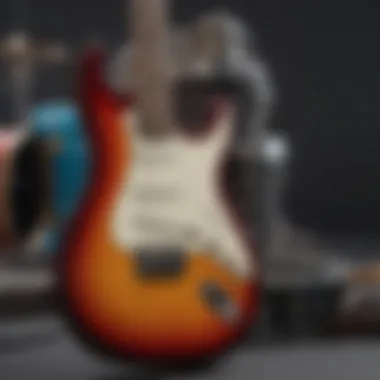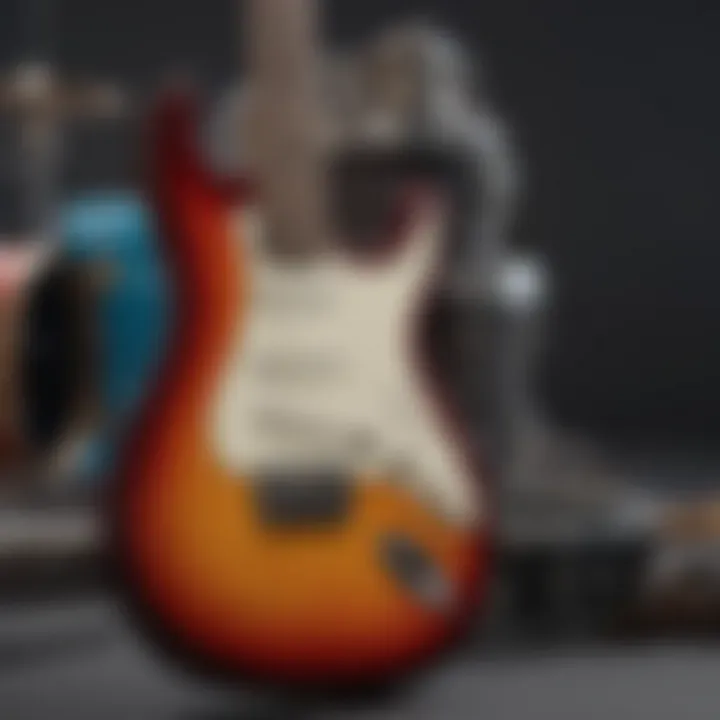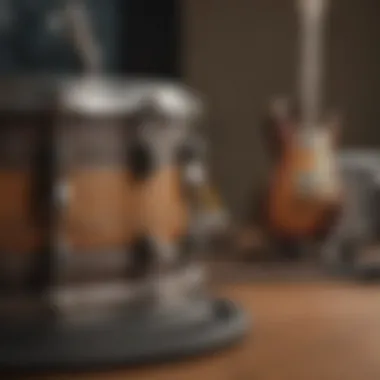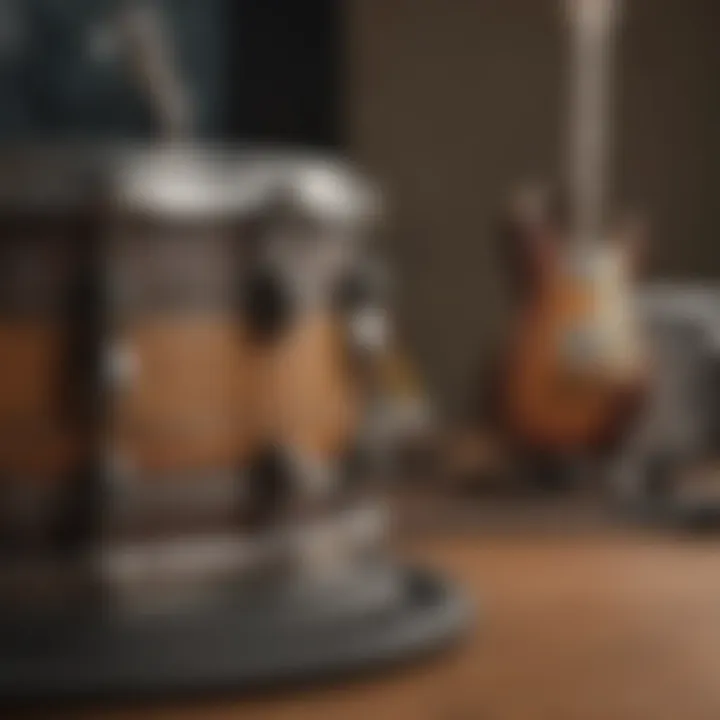The Harmonious Blend of Guitar and Snare in Music


Intro
The intersection of guitar and snare plays a pivotal role in modern music. Both instruments, with their distinct sounds and characteristics, contribute significantly to the overall musical experience. The guitar serves as a harmonic foundation while the snare drum provides rhythmic structure. Together, they create a synergy that is fundamental across various genres, from rock to jazz to pop.
Understanding how these two elements interact requires a close look at their individual capabilities. The guitar is versatile and able to convey emotion through chords and solos. On the other hand, the snare drum offers a sharp, crisp sound that punctuates the rhythmic landscape. Their combined sound often defines the essence of a track, making their study essential for any serious music enthusiast.
In this article, we will delve into these elements, exploring their historical context, technical aspects, and notable examples. We aim to contextualize their influence and see how they shape contemporary soundscapes.
Artist Profile
Biography and Background
To illustrate the intersection of guitar and snare, we can look at artists who have mastered both instruments. Consider Dave Grohl, the frontman of the Foo Fighters and former drummer for Nirvana. His unique ability to shift seamlessly between guitar and drumming showcases the profound interplay between these two musical components within his works.
Dave Grohl's journey began in Virginia, where he was born in 1969. He started playing guitar at a young age, but it wasn't until he picked up the drums that his career took off. His time in Nirvana pushed the boundaries of rock music and highlighted how guitar and snare can work in harmony to create powerful auditory experiences.
Major Influences and Inspirations
Dave Grohl has cited multiple influences throughout his career. Punk rock, heavy metal, and classic rock bands shaped his musical sensibilities. Bands like the Ramones and Led Zeppelin provided a framework for his musical style. This amalgamation of influences is evident in his writing, where the guitar’s melodies interact dynamically with the snare's rhythms.
Understanding an artist's influences allows us to appreciate the depth of their music. Grohl's use of guitar riffs paired with engaging snare patterns not only defines his sound but also influences many others who follow in his footsteps.
Song Analysis
Theme and Lyrics Breakdown
Analyzing a specific song like "Everlong" by the Foo Fighters reveals the synthesis of guitar and snare. The song addresses themes of longing and emotional connection. Grohl's guitar work creates a sense of yearning, while the steady snare rhythm anchors these feelings, allowing them to resonate with the listener.
The lyrics complement this theme, illustrating emotional highs and lows, and the instrumentation supports the narrative. This harmony between lyrics, guitar, and drums exemplifies the crucial relationship between guitar and snare.
Instrumentation and Composition
"Everlong" features a simple yet effective combination where the guitar chords create a melodic framework, while the snare beats punctuate each lyrical phrase. This interaction contributes to the driving energy of the song.
The following points detail how this composition uses both instruments:
- Guitar: The electric guitar sets the mood with its clean, rhythmic chords, creating lush sound layers.
- Snare Drum: The snare provides accentuation, emphasizing each beat and enhancing the song's urgency.
This intricate dance between guitar and snare is what elevates pieces like "Everlong" to become classics, illustrating their indispensable roles across modern musical genres.
Foreword to Guitar and Snare
The intersection of guitar and snare drum is a crucial aspect of modern music. Both instruments, while distinct, create a unique synergy that defines various genres and musical styles. Understanding their roles enhances appreciation for how music is crafted today.
The guitar serves as a versatile instrument. It can provide rhythm, harmony, or melody depending on the context. It is present in many styles, from rock and blues to jazz and folk. The snare drum, on the other hand, is central to the rhythm section. It contributes sharp, crisp beats which anchor the music.
Focusing on the interplay between these two instruments allows for deeper insights into their contributions. It is important to explore how guitar chords complement snare patterns, creating a cohesive sound. Additionally, learning different techniques adds layers of complexity, enriching one's musical experience.
In this section, we will define the guitar and detail its characteristics, followed by an exploration of the snare drum and its unique qualities. Together, these considerations lay the groundwork for understanding their collaborative potential in modern music.
Defining the Guitar
The guitar is a stringed instrument, known for its versatility. It serves multiple roles and is adaptable across many genres. Often, it is used to form the backbone of a band or ensemble.
Key characteristics of the guitar include:
- Types: Acoustic guitars produce sound naturally, while electric guitars require amplification.
- Tuning Variations: Standard tuning is common, but many musicians use alternate tunings to achieve different sounds.
- Techniques: Strumming, picking, and fingerstyle showcase the instrument's versatility and applicability in various styles.
Understanding these features helps to appreciate how the guitar interacts with other instruments, especially the snare drum.
Understanding the Snare Drum
The snare drum is an essential part of the drum kit. Its sharp, distinct sound adds a dynamic quality to any composition. It usually sits in the front of the kit, making it accessible for drummers to use in various musical contexts.
Main components of the snare drum include:
- Shell: Made from wood or metal, the material affects the sound significantly.
- Heads: Top and bottom drum heads contribute to the overall tone and pitch.
- Snares: The metal wires on the bottom head create that signature crisp sound, making the snare easily recognizable.


Techniques for playing the snare vary widely. For instance, basic sticking patterns lay the foundation for more complex rhythms. Advanced techniques can involve flam strokes or rim shots, adding more texture and dynamics to the performance.
In capturing the complexities and uniqueness of both instruments, we prepare to explore how they combine, interact, and shape the soundscape of modern music.
Historical Context of Guitar and Snare
The historical context of guitar and snare drum provides crucial insights into the evolution of modern music. Understanding how these instruments developed and interacted over time reveals their individual and collective significance. The guitar, with its roots traced back to the ancient lute, has undergone transformations that have allowed it to adapt to various musical styles. Similarly, the snare drum, prominent in military bands, evolved into a core component of contemporary rhythm sections. This historical narrative is essential for music enthusiasts who seek to appreciate their current roles in today’s genres.
Evolving Roles in Music History
The roles of the guitar and snare have significantly transformed across different epochs in music history. Initially, the guitar served mainly as a solo and accompaniment instrument in folk and classical music. With the advent of blues in the early 20th century, guitarists began to explore expressive techniques, which influenced rhythm and harmonization. This contributed to the development of modern rock and popular music.
The snare drum, meanwhile, started its journey within military contexts, primarily used for signaling commands and keeping marching rhythms. As genres like jazz and rock emerged, the snare transitioned into a more central role. Its sharp, crisp sound became indispensable for maintaining tempo and adding texture to a performance. The combination of the guitar's melodic potential and the snare's rhythmic clarity created a synergy that defined many music genres.
Cultural Significance Across Genres
Throughout various musical genres, the cultural significance of guitar and snare cannot be understated. In rock music, power chords played on the guitar, coupled with dynamic snare patterns, create anthems that resonate with audience passions. Heavy metal bands utilize intricate guitar solos and aggressive snare strikes, emphasizing energy and skill.
In jazz, the guitar takes on a more subtle role, often executing complex chord progressions while the snare drum accentuates the swing feel. This collaboration showcases musical sophistication, where both instruments support a sophisticated dialogue.
Pop music often blends these elements even further, incorporating the acoustic guitar and snare into catchy hooks and rhythmic backdrops. This melding reflects the evolving tastes of contemporary audiences and showcases the versatility of both instruments.
The interplay between guitar and snare is not just about sound; it encapsulates a rich history of cultural expression.
In summary, the historical context surrounding the guitar and snare showcases their evolving roles and cultural significance. Their rich histories inform today's music and underscore the importance of understanding their collaboration in shaping modern sounds.
Technical Aspects of Guitar Playing
The technical aspects of guitar playing are crucial in understanding the synergy between guitar and snare in modern music. Each element of playing contributes significantly to the overall sound and texture of a piece. Mastery of guitar techniques allows musicians to explore a myriad of musical styles and express themselves more vividly. Without a good grasp of these technical elements, the bridge between guitar riffs and snare rhythms may weaken, detracting from a song's impact.
Guitar Types and Their Characteristics
Acoustic Guitars
Acoustic guitars are often the first instrument for many aspiring musicians. They produce sound naturally without the need for electronic amplification, which makes them versatile in different settings. The key characteristic of acoustic guitars is their body, which can be of various types such as dreadnought or concert style.
One unique feature that acoustic guitars offer is their warm and resonant tone. This quality can benefit acoustic performances greatly, especially in folk or country genres. However, a disadvantage is that they might be less effective in larger spaces compared to electric guitars, mainly due to their limited sound projection capabilities.
Electric Guitars
Electric guitars have become integral in modern music, characterized by their reliance on electronic pickups to amplify sound. This fundamental attribute allows for a broad range of tones and effects that can be manipulated during performance.
A notable feature is the ability to use a variety of pedals, which gives musicians flexibility in achieving different sounds. Electric guitars are popular in genres like rock, jazz, and metal, due to their powerful output and capability to sustain notes for longer periods. On the downside, some might consider them challenging for beginners, as they often require additional equipment like amplifiers and effects pedals.
Techniques for Expressive Play
Strumming and Picking
Strumming and picking techniques are essential for creating rhythm and harmony in guitar playing. Strumming involves sweeping the fingers or pick across the strings, producing a fuller sound, which is particularly effective in lively genres. Picking, on the other hand, refers to plucking individual strings, allowing for intricate melodies and solos.
This duality in techniques is beneficial for the versatility of the guitar. The unique quality of strumming is its ability to create a driving rhythm that pairs well with the snare drum's backbeat. However, depending on skill level, inconsistencies in strumming patterns might emerge during live performance, complicating the interplay with the snare.
Fingerstyle Approaches
Fingerstyle guitar playing emphasizes using the fingers directly rather than a pick, creating a more intimate and nuanced sound. This technique blends harmony and melody in a unique way, making it favorable in genres such as classical and folk.
The advantage of fingerstyle lies in its complexity and expressiveness. It allows players to create rich textures that can smoothly fuse with snare rhythms. However, mastering fingerstyle often requires significant practice as it involves coordination among multiple fingers for intricate patterns.
In summary, the technical aspects of guitar playing embody both acoustic and electric styles with various techniques that contribute richly to modern music. Understanding these elements is pivotal for musicians who aim to achieve a harmonious collaboration between guitar and snare.
Technical Aspects of Snare Drum Playing
Understanding technical aspects of snare drum playing is essential for grasping its role alongside the guitar in modern music. The snare drum contributes to the overall texture of a performance, serving as a crucial rhythmic foundation. Musicians who master the snare’s technical details can enhance the seamless integration between guitar and drum, leading to a more dynamic and engaging musical experience.
Components and Variants of Snare Drums
Snare drums come in various components and configurations, each offering distinct sounds and characteristics. The main features include the shell material, diameter, and the types of heads used. Common materials for the shells include wood varieties like maple and birch, as well as metal options like steel or brass. Each material provides a different tone quality.


Other important aspects include the snare wires and how they are tensioned. The snare wires, usually made of metal, are critical for producing the characteristic "crack" sound of the drum. Variants like the American-style snare drum and the European-style offer different tonal profiles. Understanding these details helps musicians select the right snare drum for their style, bringing out the best in their performances.
Techniques for Dynamic Rhythm
Basic Sticking Patterns
The essence of basic sticking patterns lies in its simplicity and effectiveness in establishing rhythmic foundations. These patterns are typically learned first by drummers because they are easy to understand and can be applied across different styles of music. A common example is the single-stroke roll, often the starting point for new drummers. This pattern involves alternating strokes with both hands, ensuring a steady and even flow.
A key characteristic of basic sticking patterns is their versatility. They are beneficial for both live performances and studio recordings. In the context of this article, basic sticking patterns provide a reliable rhythmic backdrop over which guitarists can structure their melodies. However, some might find these patterns limiting as they may not offer the complexity desired for more advanced arrangements.
Advanced Techniques
Advanced techniques on the snare drum expand the possibilities for rhythmic expression and enhance the interplay with the guitar. Techniques like ghost notes, rimshots, and paradiddles create a nuanced rhythmic landscape. Ghost notes, for instance, involve playing softer strokes that add texture without overwhelming the primary beats. This subtlety becomes vital in genres like jazz or blues, where interplay is key.
The benefit of advanced techniques is primarily in adding layers and complexity. Musicians can create distinctive grooves that stand out in any arrangement when executed correctly. However, these techniques require considerable skill and practice, which might pose challenges for less experienced drummers. In this article, understanding advanced techniques is crucial as they showcase the breadth of expression possible on the snare, particularly in collaboration with guitarists.
In Summary: Mastering the technical aspects of snare drumming allows musicians to enhance their overall sound. Understanding the components, learning basic patterns, and exploring advanced techniques are invaluable for any drummer. This depth of knowledge directly influences the synergy with the guitar, pushing boundaries within modern music.
The Synergy of Guitar and Snare
The relationship between guitar and snare drum is fundamental in shaping modern musical landscapes. This synergy exemplifies how two distinct instruments can come together to create a cohesive sound. Understanding this interaction offers insights into the various ways these instruments enhance musical expression.
Creating a Cohesive Sound
The combination of guitar and snare contributes to a unified sonic experience. Each instrument brings unique tonal qualities that, when intertwined, achieve a harmonious blend. The bright resonance of the guitar often complements the sharp, crisp attack of the snare drum. This interplay allows for dynamic range—guitars can provide chords and melodies while snares deliver rhythm and pulse. A well-executed arrangement of both instruments can elevate a piece of music from mere sounds to a structured composition.
Role in Different Musical Genres
Musical genres dictate how guitar and snare collaborate, shaping their roles accordingly. The adaptability of both instruments means they can be tailored to fit various styles, enriching the overall sound.
Rock and Metal
In Rock and Metal, the guitar often takes center stage with aggressive riffs and powerful solos. The snare drum plays a crucial role by providing a steady pulse that drives the music forward. This genre thrives on intensity; the sharp crack of the snare accents the guitar's riffs, creating a forceful atmosphere. The unique feature of layered guitar solos over relentless snare rhythms fosters an energizing sound. While this style is popular, it can risk overshadowing other elements in a mix, thus requiring care in production.
Jazz and Blues
Jazz and Blues present a more subtle use of guitar and snare. Here, guitars often engage in intricate melodies or improvisation, while snare drums maintain a laid-back groove. The primary characteristic of these genres is their focus on feel and expression, allowing for personal interpretation. This flexibility makes them beneficial for exploring complex musical ideas. However, the challenge lies in ensuring that both instruments coexist rather than compete for attention. The unique aspect of syncopation in these styles can create exciting moments that highlight their synergy.
Pop and Contemporary Genres
In Pop and Contemporary genres, the guitar and snare work together to create catchy hooks and rhythms. The guitar often supports melody lines while the snare annotates the beat, contributing to the danceability of the music. This collaboration is widely appreciated for its accessibility, making it a favorable choice for mainstream audiences. The unique feature of production techniques such as layering and digital enhancements allows for a richer sound, though it can sometimes lead to a formulaic approach to songwriting.
The successful integration of guitar and snare can define the character of a song and influence its success across diverse genres.
Understanding the roles of guitar and snare in these different musical settings provides a framework for appreciating their contributions. Each genre leverages the strengths of both instruments, showcasing their versatility and importance in modern music.
Notable Collaborations of Guitar and Snare
The integration of guitar and snare drum in modern music has led to remarkable collaborations. These partnerships between artists create a unique auditory experience. Understanding the significance of notable collaborations is essential. They reflect creative innovation, where rhythm and melody intertwine. The synergy often enhances the overall sound.
Influential Artists and Bands
Through the decades, numerous artists have effectively combined guitar and snare. This collaboration results in iconic sounds that define genres and eras. One iconic band is The Beatles. Their experiments blended intricate guitar riffs with robust snare patterns. Another prominent example is Led Zeppelin. Their use of snare accents in songs like "Whole Lotta Love" emphasizes the power of these two instruments.
Nirvana also showcases effective combinations. Their song "Smells Like Teen Spirit" features a prominent snare that complements the distorted guitar. Moreover, in jazz, artists like Miles Davis and Herbie Hancock explored how contrasting styles could create depth.
These artists illuminate the potential of snare and guitar combinations. Their music encourages musicians to explore this interplay further.
Iconic Songs Featuring Guitar and Snare
Several songs exemplify the collaboration between guitar and snare, which contributes to their distinctiveness. For instance, "Smoke on the Water" by Deep Purple features a famous guitar riff paired with rhythmic snare hits. This fusion is fundamental to its catchiness and overall appeal.
"Seven Nation Army" by The White Stripes is another classic example. The minimalist guitar line interplays smoothly with the strong, steady snare. Both elements combine to create a hauntingly memorable track.
In the realm of pop, "Uptown Funk" by Mark Ronson features a masterful blend of snare shots driving the beat forward while the guitar adds flair. This combination produces a lively and compelling rhythm that enhances the song's energy.
"The combination of guitar and snare is essential in delivering rhythmic cohesion and melodic interest."


These songs highlight how guitar and snare collaborations shape the soundscape of modern music. They create a texture that resonates with listeners and influences future compositions.
Challenges in Integrating Guitar and Snare
Integrating the guitar and snare drum within a musical composition presents various challenges. Understanding these challenges is crucial for musicians who seek to create a harmonious sound. This section will explore specific elements such as mixing and production issues, live performance dynamics, and how these aspects can affect the overall performance quality and audience experience.
Mixing and Production Issues
When mixing guitar and snare in a track, balancing the two instruments is essential. Each has its unique frequency range which can overlap, resulting in a cluttered sound if not managed properly. For instance, the snare drum typically occupies a sharp and bright sound in the higher frequencies, while the guitar can cover a broader spectrum of tones.
Achieving clarity requires precise equalization (EQ). A common practice is to carve out a space for each instrument in the mix. For example, reducing certain frequencies in the guitar can help the snare cut through more effectively in the mix.
Moreover, dynamic range plays a significant role. The snare's attack is powerful, which can overshadow the subtleties of the guitar. Implementing proper compression techniques ensures that both instruments maintain their presence without overpowering each other.
To consider:
- Ensure complementary EQ settings.
- Apply compression to control dynamics.
- Test mixes on different sound systems.
Live Performance Dynamics
Performing with both guitar and snare introduces additional dynamics that can affect the audience's experience. In live settings, sound can vary significantly from a studio environment. A common challenge is ensuring that both instruments are adequately amplified. If the guitar is too loud, the snare may not be heard as well, and vice versa.
Sound checks become vital in these circumstances. Musicians must listen carefully to how each instrument resonates in the venue. Adjustments in mic positioning and amplification can help tailor each sound based on the room's acoustics.
Another element to consider is the interaction between players. The guitarist and drummer must have an established connection, both rhythmically and dynamically. Their communication is key to maintaining a tight performance. Uncertainty or lack of synchrony can lead to a disjointed sound. Thus, individuals should rehearse together to develop a cohesive rhythm.
"Live performances demand a balance and understanding that studio recordings do not always require."
In summary, integrating guitar and snare drums poses challenges in mixing and live performance. Musicians must consider production techniques while being aware of their dynamic interactions during performances. Addressing these challenges helps create a rich auditory experience.
Future Trends in Guitar and Snare Collaboration
The dynamics between guitar and snare in the modern music landscape are ever-evolving. As musicians continue to blend styles and explore new sonic possibilities, understanding future trends in guitar and snare collaboration becomes crucial. This aspect is significant for any music enthusiast or aspiring musician, as it highlights how these two instruments can coalesce to form innovative soundscapes. Amidst the rapid changes in music consumption and production, the collaboration between guitar and snare will likely reflect broader developments and shifts in both the musical and technological arenas.
Emerging Genres and Styles
The emergence of diverse genres presents fresh avenues for guitar and snare interaction. New forms of music such as trap, ambient, and even progressive rock are reinterpreting the roles of traditional instrumentation. In trap music, for instance, the snare often plays a pivotal role, creating sharp, staccato rhythms. Electric guitar riffs can accentuate these beats, leading to a unique fusion that captures the essence of modern hip-hop. Similarly, ambient music often explores the textural qualities of guitar through effects pedals, while the snare serves as a dynamic pulse that anchors the composition.
Moreover, the integration of global music influences is reshaping genres. Artists like Hozier blend folk guitar sounds with rhythmic snare accents, creating a hybrid that appeals to a broad audience. This fusion signifies a meaningful trend where guitar and snare collaborate across boundaries, resulting in music that is both reflective and innovative.
- Key points to watch:
- Fusion of styles: Unexpected combinations of genres can bring out new collaborative potential.
- Cultural crossovers: Artists are increasingly drawing from diverse musical heritages.
This approach emphasizes that music is a living ecosystem, continually shaped by cultural exchanges and experimental zeal.
Advancements in Technology
Technology significantly influences how guitar and snare work together in contemporary music. The rise of digital audio workstations (DAWs) and software plugins allows for intricate layering and manipulation of sounds. Musicians can now edit their guitar and snare interactions with remarkable precision.
For example, guitarists can employ MIDI-controlled effects that seamlessly integrate their sound with the snare, allowing them to explore new rhythmic dimensions. Additionally, the growing availability of electronic drums adds another layer to the snare's role. These electronic drums can emulate traditional snare sounds while providing versatility that complements various guitar styles.
Furthermore, advancements in audio recording techniques have enabled better capture of live performances. High-definition recording and mixing technology provide clarity and depth, enhancing the collaborative sound of guitar and snare. These developments highlight the future of music as increasingly reliant on technological innovation, promoting creativity and redefining traditional roles.
Finale
In this article, we explored the significant interplay between guitar and snare drum, critical instruments shaping modern music. This conclusion synthesizes the insights discussed and emphasizes the pivotal role these instruments hold in various musical landscapes. Their collaboration highlights unique capabilities, where guitar offers harmonic depth while the snare provides rhythmic clarity.
One of the key insights is how the historical evolution of both instruments has led to a rich tapestry of sound across genres. The guitar’s evolution from classical roots to electric variants parallels the snare drum’s journey from basic percussion to complex layering in contemporary compositions. This evolution is not merely historical; it influences how new artists approach songwriting and arrangements today.
Moreover, understanding the technical aspects of playing each instrument enhances appreciation for their synergy. The techniques used in guitar playing, such as fingerstyle and strumming patterns, can significantly affect how they blend with snare rhythms. Similarly, drum techniques, from basic patterns to intricate fills, can complement guitar chords, creating a unified musical expression.
The relevance of this exploration extends beyond academia; it serves as guidance for aspiring musicians. By delving into the intricacies of how guitar and snare work together, musicians can experiment with their compositions. They learn to prioritize dynamics and cohesion, improving overall sound.
Summary of Key Insights
- The historical significance of both guitar and snare drum contributes to their current roles in music.
- Technical understanding of each instrument is crucial for effective integration.
- Collaboration leads to a greater understanding and appreciation of musical textures.
- Emerging genres continue to innovate how these instruments can be paired, suggesting a bright future for their collaboration.
Encouragement for Further Exploration
As music evolves, the relationship between guitar and snare drum continues to transform. Aspiring musicians are encouraged to explore various genres and styles further. Listening to diverse music and analyzing how guitar and snare interact can offer insight into composition techniques and performance dynamics. Online platforms, like Reddit, can serve as forums for exchanging ideas and experiences.
Engaging with music communities on platforms like Facebook allows for discussions that can enhance your musical journey. Ultimate enjoyment comes from experimenting with your own unique sound, inspired by the techniques discussed. The pathway of exploration is not only educational, but it contributes to personal growth as an artist. Keep searching, practicing, and enjoying the art of music.







